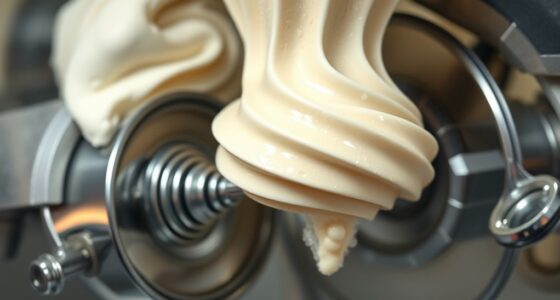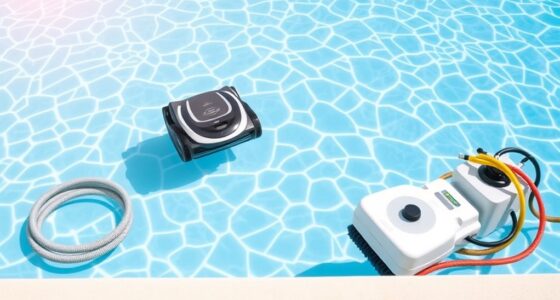To improve filter rinsing on a budget, use cold water instead of hot to save energy and prevent damage. Incorporate simple agitation techniques like swirling or tapping during rinsing. Use household supplies like dish soap or vinegar to loosen debris. Maintain a steady flow of water and rinse for 1-2 minutes. Regularly clean and soak filters to remove buildup easily. Keep your filters in top shape—more tips await that can make the process even easier and lasting.
Key Takeaways
- Rinse filters with cold water and gentle agitation to save energy and prevent damage.
- Soak filters overnight in warm water with household supplies like vinegar or baking soda for easier cleaning.
- Use common household items such as mild dish soap or vinegar to loosen dirt and mineral buildup effectively.
- Maintain a steady water flow during rinsing for 1-2 minutes to maximize debris removal efficiently.
- Utilize affordable accessories like flexible hoses or clip-on brushes to enhance rinsing without high costs.
Use Cold Water Instead of Hot Water
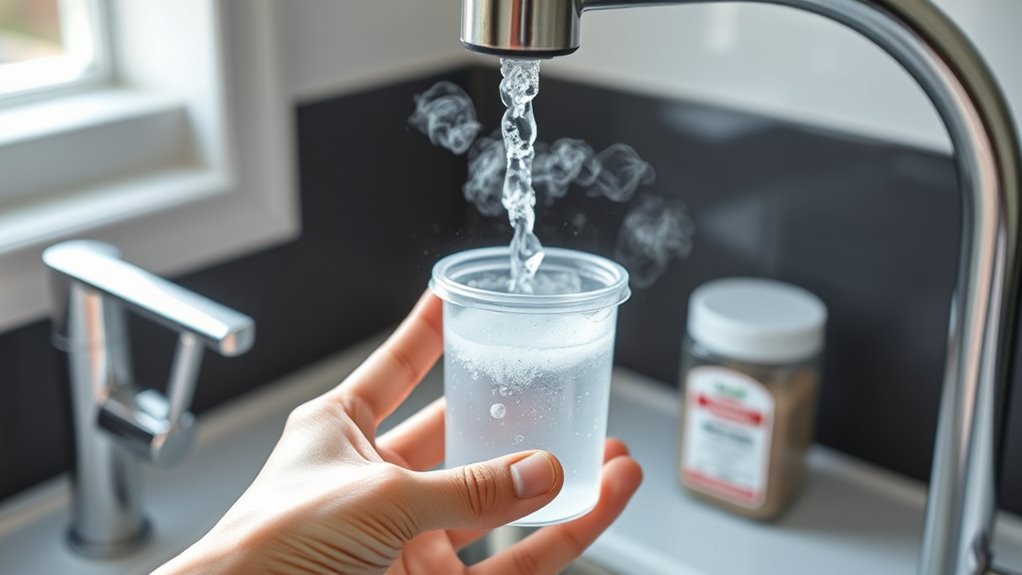
Switching to cold water for filter rinsing can save you money and energy. Using cold water instead of hot reduces your electricity bill since you won’t need to heat water. Plus, cold water helps maintain filter efficiency by preventing the breakdown of certain filter materials caused by high temperatures. Hot water can cause some filters to warp or degrade over time, leading to more frequent replacements and increased costs. Cold water effectively loosens dirt and debris without compromising the filter’s integrity. This simple change requires no special equipment and is easy to implement. Not only does it save you money, but it also extends the lifespan of your filters, making your rinsing routine more budget-friendly and sustainable. Additionally, choosing appropriate cleaning solutions compatible with cold water ensures thorough cleaning without damaging the filters.
Incorporate Simple Mechanical Agitation Techniques
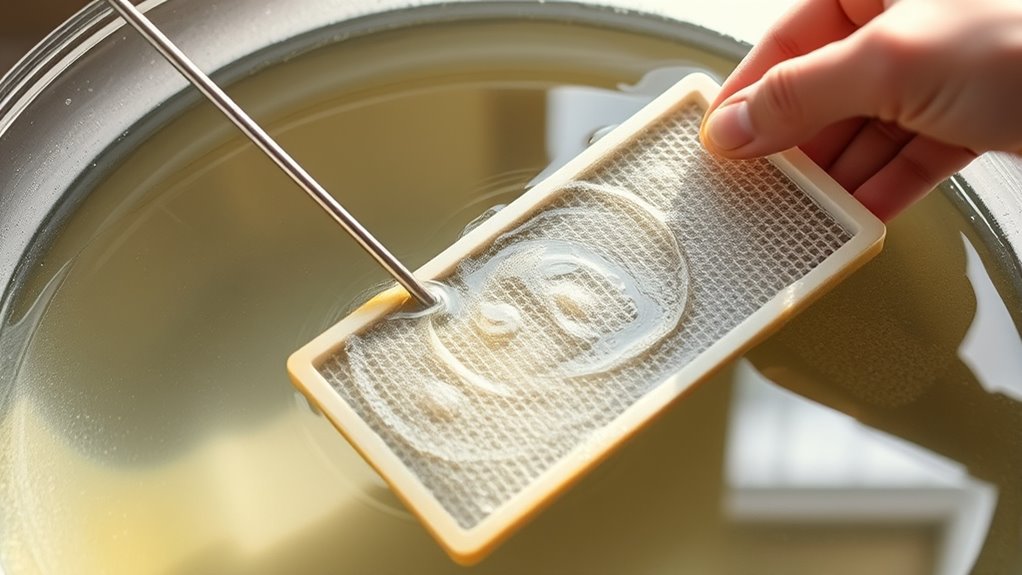
You can improve filter rinsing by adding gentle mechanical agitation. Try stirring softly, tapping the filter lightly, or swirling the water to loosen debris. These simple actions help clean more effectively without extra equipment or cost. Additionally, filter maintenance is essential for ensuring your purifier’s optimal performance and air quality.
Use Gentle Stirring
Even gentle stirring can considerably improve filter rinsing without adding extra cost. By applying slow agitation, you help dislodge particles trapped in the filter’s pores, ensuring a more thorough clean. Gentle stirring is simple—just move the liquid or filter gently back and forth or swirl it carefully. This slow agitation prevents damage to delicate filter materials while enhancing rinsing effectiveness. You don’t need any special tools; your hands or a spoon suffice. The key is to maintain a steady, gentle motion that encourages water to flow evenly through the filter. This method saves money on specialized equipment and reduces the risk of tearing or deforming the filter. Additionally, understanding the mechanics of pinball machines can inspire creative ways to optimize your cleaning techniques, as both involve intricate components that require careful handling. Overall, gentle stirring is an easy, budget-friendly way to boost your filter rinsing process.
Tap the Filter Gently
Building on gentle stirring, tapping the filter can further enhance rinsing without extra tools or costs. Use gentle tapping with your fingertips, applying soft handling to avoid damaging the filter. This simple mechanical agitation loosens trapped debris and ensures water flows through more effectively. Keep your taps light—avoid pounding or pressing too hard—to prevent any damage or deformation. By incorporating gentle tapping into your rinsing routine, you help dislodge stubborn particles without resorting to harsh methods. Remember, the key is soft handling combined with gentle taps, making the process both effective and budget-friendly. Proper filter maintenance is essential for ensuring optimal performance and prolonging the life of your filter. With consistent practice, you’ll notice cleaner filters and better rinsing results.
Swirl During Rinsing
To enhance rinsing, try swirling the filter gently in the water instead of just holding it still. This simple rinsing technique creates slight mechanical agitation, helping loosen debris from the filter surface. By moving the filter in small circles, you increase contact between the water and filter surface, ensuring a more thorough clean. This method prevents stubborn particles from sticking and improves overall rinsing efficiency without extra cost. Be careful not to swirl too vigorously, as aggressive agitation could damage delicate filter materials. Instead, aim for slow, controlled movements that maximize mechanical action. Incorporating this swirl technique into your routine can considerably boost the effectiveness of your rinsing process, especially when combined with gentle tap water flow. Additionally, protective styling methods like crochet styles can help keep filters cleaner longer by reducing debris buildup. It’s an easy, budget-friendly way to upgrade your filter maintenance.
Utilize Basic Household Cleaning Supplies
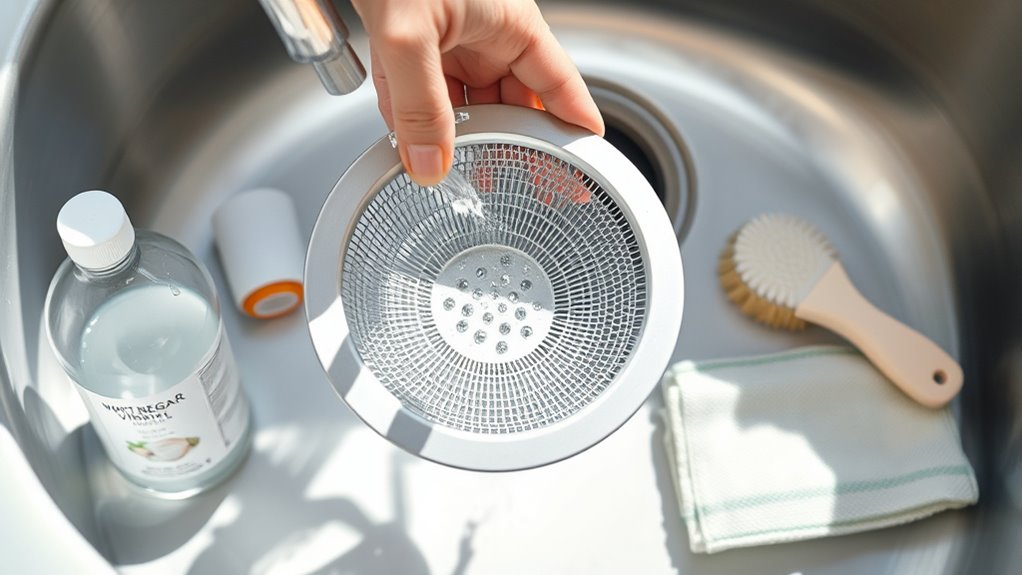
Did you know that common household cleaning supplies can be effective tools for rinsing your filters? You can use items like mild dish soap, vinegar, or baking soda to help clean different filter materials without extra cost. These supplies can loosen dirt and mineral buildup, making rinsing more thorough. Just mix a small amount of soap or vinegar with water, then soak or scrub the filter gently. Remember, cleaning frequency is key—regular rinsing prevents debris from accumulating and extending filter life. Always check your filter material’s guidelines before using household cleaners to avoid damage. Using household cleaning supplies not only saves money but also reduces the need for specialized products. By incorporating simple, everyday supplies into your routine, you’ll improve filter rinsing efficiency without spending extra money, keeping your system running smoothly and maintaining cleaner water.
Optimize Flow Rate and Rinsing Duration
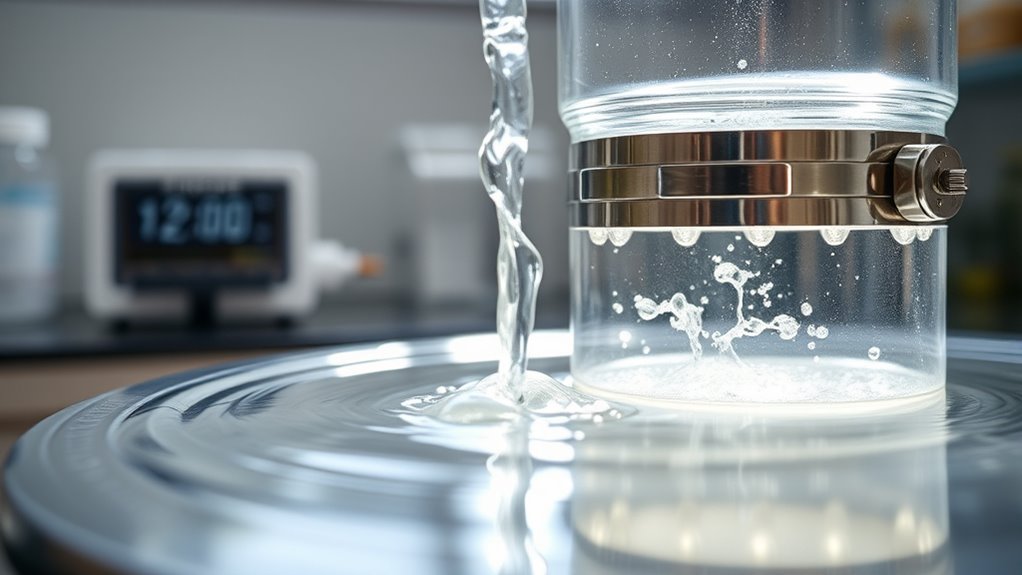
Using household cleaning supplies can make your filter rinsing more effective, but how you rinse also matters. Adjusting your flow rate helps remove debris without damaging the filter. Use a gentle, steady flow to prevent tearing or clogging, and avoid high pressure that may force particles deeper into the material. Rinsing duration strategies involve balancing thorough cleaning with efficiency; rinsing too briefly might leave residue, while over-rinsing wastes time. Typically, a 1-2 minute rinse with moderate flow suffices. Pay attention to how the water flows through the filter—if it’s slow or uneven, tweak the flow rate. Consistent, controlled rinsing ensures debris is washed away while preserving the filter’s lifespan, all without spending extra money. Incorporating proper microphoned microphone handling techniques can also help maintain the integrity of sound equipment during cleaning.
Maintain and Clean Your Filters Regularly
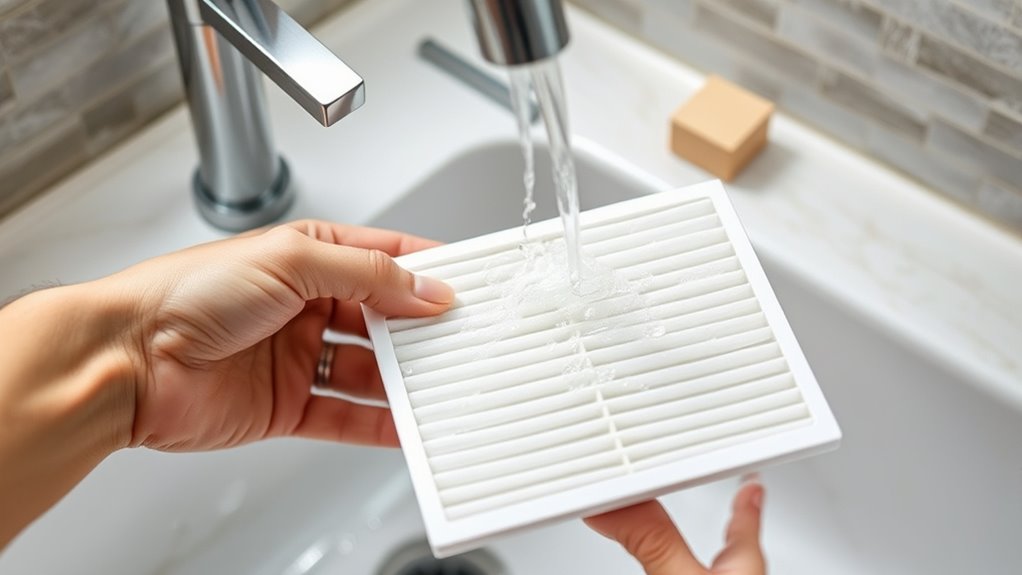
Regularly maintaining and cleaning your filters is essential to guarantee they work efficiently and last longer. Proper attention ensures ideal filter material selection and adherence to your filter replacement schedule, saving you money.
Here are four key steps:
- Inspect filters regularly for dirt buildup or damage.
- Clean filters according to manufacturer instructions, avoiding harsh chemicals.
- Replace filters based on your established filter replacement schedule to prevent clogging.
- Consider upgrading filter material if current options are ineffective or costly over time.
Implement Pre-Rinsing or Soaking Methods

Pre-rinsing or soaking your filters can make cleaning more effective and save you time. Try soaking filters overnight or using mild detergents to loosen debris without harsh chemicals. Always rinse thoroughly before reuse to guarantee peak performance and clarity. Incorporating regular filter maintenance into your routine ensures optimal air purification and prolongs the lifespan of your appliance.
Soak Filters Overnight
Soaking filters overnight can substantially reduce the effort needed to rinse away stubborn debris. By allowing time for the filter to absorb water, you loosen residue buildup and prevent filter saturation from becoming overwhelming during cleaning. This method makes rinsing more effective and less labor-intensive. To maximize results, consider these steps:
- Use warm water to enhance residue breakdown.
- Add a small amount of vinegar or baking soda for natural cleaning.
- Ensure the filter is fully submerged for even soaking.
- Avoid over-soaking to prevent damage or warping.
- Proper soaking can also help preserve the filter’s material integrity and extend its lifespan.
This simple step helps loosen stubborn particles, making the subsequent rinse faster and more thorough. Consistently soaking filters overnight minimizes residue buildup and maintains filter performance, saving you time and effort during cleaning.
Use Mild Detergents
After soaking filters overnight to loosen debris, using a mild detergent can further simplify the cleaning process. Choose a detergent compatible with your filter material to prevent damage or deterioration. Mild detergents effectively break down oils, dirt, and residues without harsh chemicals that could harm delicate filter components. Always check the label to ensure compatibility with your specific filter material, whether it’s paper, foam, or mesh. Applying a small amount of the detergent and gently agitating the filter helps loosen stubborn buildup. This step reduces the need for vigorous scrubbing, saving time and effort. Rinse thoroughly afterward to remove all detergent traces. Utilizing digital literacy programs can help seniors stay informed about safe and effective cleaning methods. Using mild detergents is a budget-friendly method that maintains filter integrity while ensuring a cleaner, more efficient filter.
Rinse Thoroughly Before Use
Before using your filter, it’s important to rinse it thoroughly to remove any residual debris or detergent. Proper rinsing guarantees the filter material is clean and won’t introduce contaminants. To optimize rinsing, consider these steps:
- Use cold water to prevent damage to delicate filter material.
- Rinse multiple times, increasing rinsing frequency for finer filters.
- Soak the filter in water for 10-15 minutes if stubborn residue remains.
- Gently agitate the filter during rinsing to dislodge debris effectively.
This pre-rinsing process helps maintain filter performance and extends its lifespan. Remember, a thorough rinse before use reduces the need for frequent cleaning and keeps your rinsing routine budget-friendly. Proper care ensures your filter material stays clean and functional.
Choose Cost-Effective Filter Accessories and Add-ons
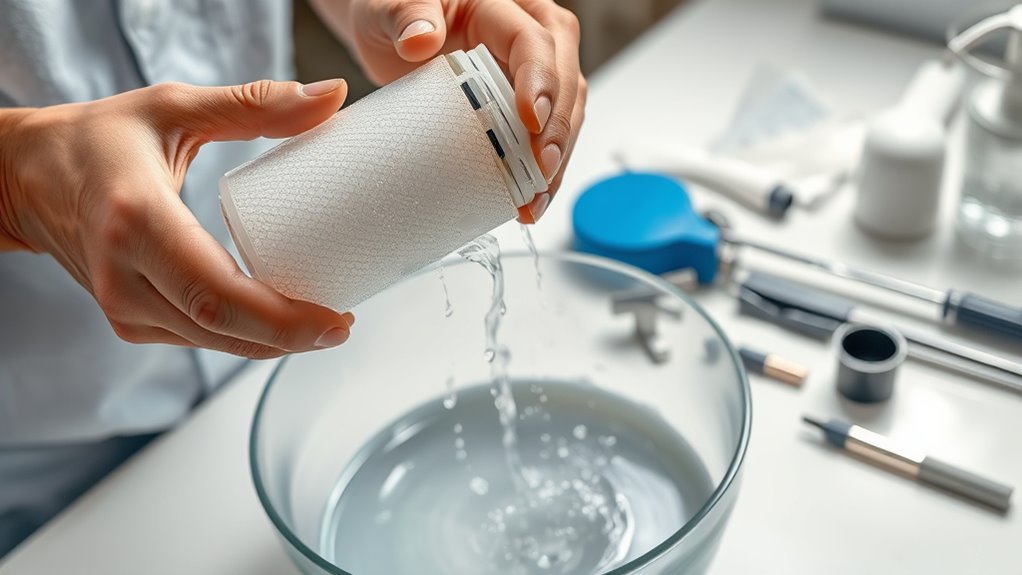
Choosing cost-effective filter accessories and add-ons can substantially enhance your filter rinsing process without breaking the bank. Look for simple filter accessory upgrades that improve rinsing efficiency, such as flexible hoses or quick-connect fittings. Budget-friendly add-ons like magnetic or clip-on brushes help remove debris more thoroughly during rinsing, saving you time and effort. These small investments can extend your filter’s lifespan and improve water flow, leading to cleaner results. Focus on versatile, durable options that are compatible with your existing equipment. By selecting affordable accessories, you avoid unnecessary expenses while optimizing performance. Remember, smart upgrades don’t have to be costly; they can make a significant difference in maintaining your filter’s effectiveness and prolonging its usability.
Frequently Asked Questions
How Often Should I Replace My Filters for Optimal Performance?
You should replace your filters based on their filter lifespan, which typically ranges from every 1 to 3 months. Check the manufacturer’s recommendations for your specific filter type, as replacement frequency can vary. Regularly inspecting your filters helps guarantee peak performance and air quality. Don’t wait too long—neglecting timely replacements can reduce efficiency and increase energy costs. Stay proactive to keep your system running smoothly and your indoor environment healthy.
Are DIY Filter Cleaning Methods Safe for All Filter Types?
Daring DIY methods can be delightful, but you should prioritize filter compatibility and cleaning safety. Not all filters tolerate DIY cleaning, risking damage or reduced performance. Before proceeding, check your filter’s instructions and material. If compatible, gentle rinsing with water and avoiding harsh chemicals ensures safety. When in doubt, consult manufacturer guidelines or opt for professional cleaning to protect your filter and guarantee ideal performance.
What Signs Indicate My Filter Needs Immediate Attention?
If you notice your water flow slowing down or the water looks cloudy or has a strange smell, your filter needs immediate attention. These are signs of clogged filters or water contaminants bypassing the filter. Regular filter maintenance helps prevent these issues. Don’t ignore these signs, as neglected filters can lead to poor water quality and potential health risks. Addressing these signs promptly guarantees your water stays clean and safe.
Can Filter Rinsing Improve Water Quality Significantly?
Yes, filter rinsing can considerably improve water quality. Regular filter maintenance helps remove trapped debris and contaminants, enhancing the filter’s efficiency. When you rinse your filter properly, it promotes better water purification, reduces buildup, and extends the filter’s lifespan. This simple, budget-friendly step ensures cleaner, clearer water and better overall system performance, making filter rinsing a key part of maintaining a healthy water supply at home.
How Do I Identify the Best Budget-Friendly Filter Accessories?
To identify the best budget-friendly filter accessories, you should compare options based on reviews and compatibility with your filter system. Look for essential filter accessories like replacement cartridges, pre-filters, and cleaning tools that fit your budget. Opt for trusted brands offering affordable prices, and read customer feedback to guarantee quality. This way, you can enhance your filter’s performance without overspending, ensuring you get the best value for your money.
Conclusion
By trying these budget-friendly tips, you’ll keep your filters in top shape without breaking the bank. Switching to cold water, adding simple agitation, and using household supplies are like giving your filters a spa day on a shoestring. Regular maintenance and smart choices turn rinsing from a chore into a breeze. Think of it as nurturing your filters like a garden—you’ll reap the benefits of cleaner, longer-lasting performance without draining your wallet.


